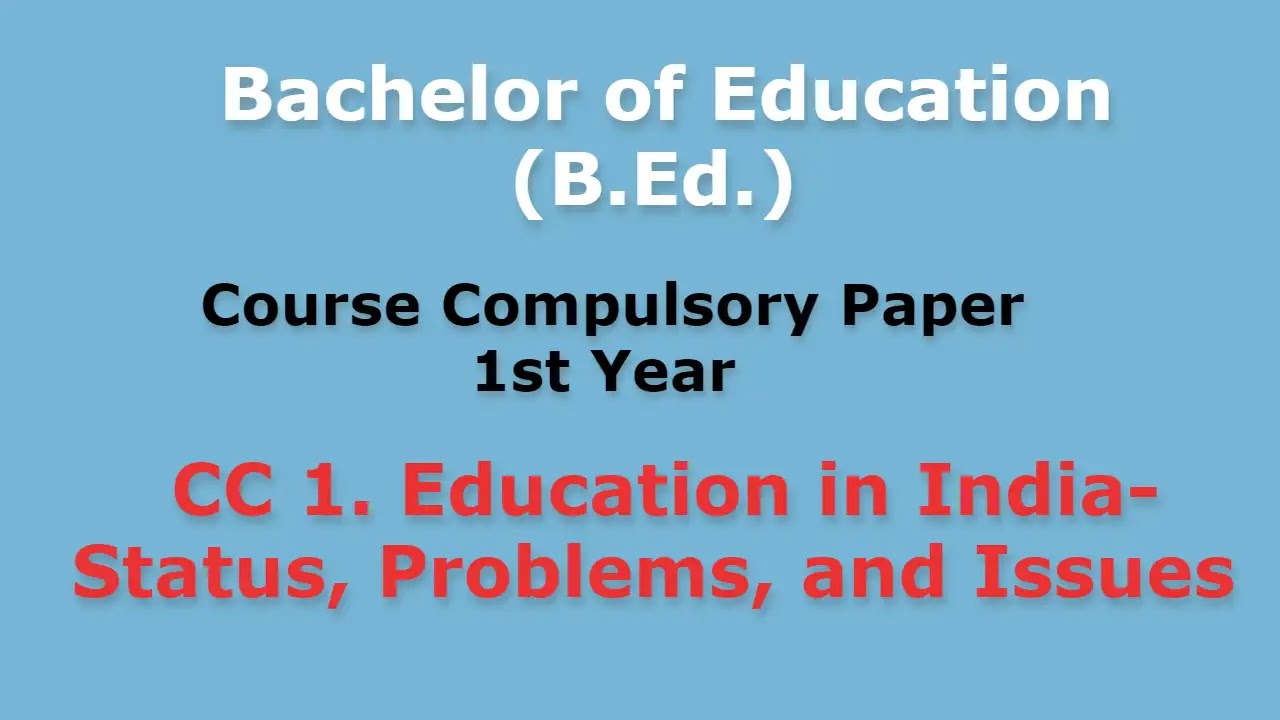SYLLABUS: Bachelor of Education (B.Ed.) Course
Compulsory Paper
1st Year
CC 1. Education in India- Status, Problems, and
Issues
Objectives:
• To develop a perception of the role and functions of a teacher as envisaged in
the NPE 1986 and to familiarize the Student Teacher with the different
projects and schemes at the Secondary level in M.P.
• To develop an understanding of the brief historical background of Indian
Education with special reference to Secondary Education.
• To develop an understanding of the objectives and scope of Secondary Education.
• To develop an awareness of professional ethics.
CONTENT
UNIT 1: Concept of Education –
• Indian and Western. Aims of Education; Functions of Education.
• Education as an instrument of Social Control, Social Change,
• Preservation of Cultural Heritage and Values.
• School and the society, Culture and Education, School as a Social System.
Agencies of Education – Informal, Formal, and Non-formal.
UNIT 2: Salient Features of Ancient Indian Education –
• Vedic, Buddhist, Islamic
• Tradition in Education.
• Major landmarks of the British System of Education in Colonial India particularly
from the viewpoint of Aims, Structure, Curricula and Methods of Education.
• Efforts towards evolving a national system of Education.
Unit -3: Secondary Education
• General Aims and Objectives of Secondary Education and Structure., Education
during Post Independence Period. Constitutional provisions for education, Secondary Education commission 1952-53, Education Commission 1964-66,
New Education Policy 1986 with programs of Action 1992,
• Different streams of Secondary Education 1) C.B.S.E. 2) I.C.S.E. and 3)
KSEEB with respect to curriculum.4) Examination System etc.,
• Secondary School Teacher – Qualifications, Competences, Job Profile,
Professional Code of Ethical conduct.
• Role of Secondary school teacher in Emerging India.
Unit – 4: Teacher Education and Secondary School Curriculum
• Status, Aims and Objectives of Teacher Education in India.
• Role and Resposibilities of NCTE NCERT, DSERT, CTE, IASE
• Professional organisation in the field of Teacher education
• Rastriya Madhyamika Shikshana Abiyana (RMSA), NCF-2005
• Programmes for enhancing efficiency and productivity of school teachers- Inservice training – orientation and content enrichment programmes.
Assignments: (Any two of the following.)
• Prepare and execute a plan for making at least two children and one
adult literate from the community.
• Plan and organize a field trip/excursion to a nearby area of
educational important and submit a report.
• Visit to block or district and divisional educational offices and study their
educational management pattern and submit the report.
• Prepare one project for institutional planning.
• Critically Study the working of one of the parent-teacher associations
in any two secondary schools.
• A critical survey of co-curricular activities in secondary schools.
Reference:
* Anand C. L. et al., (1993) Teacher and Education in the emerging Indian society NCERT New Delhi.
* Coombs Philips H (1985) The World Crisis in Education. New York. Oxford University Press, New York
* Delors, Jaeques (1996) Learning the Treasure within Report to UNESCO of the Internal Commission on Education for Twenty-First Century UNESCO.
* Dewey I (1952) Experience in Education, Collier Macmillan.
* Dewey S (1956) Democracy in Education New York: Macmillan.
* Gandhi M. K. (1956) Basic Education, Ahmedabad Nalijiban.
* Government of India (1952) Report of the Secondary Education Commission, New
Final Words
So friends, how did you like our post! Don’t forget to share it with your friends below the sharing button post. Apart from this, if there is any problem in the middle then do not hesitate to ask in the comment box. We will be happy to assist you. We will keep writing more posts related to this. So don’t forget to bookmark (Ctrl+D) our blog “Study Topper” on your mobile or computer and subscribe us now to get all the posts in your email.
If you liked this post then don’t forget to share it with your friends. You can help us reach more people by sharing it on social networking sites like WhatsApp, Facebook or Twitter. Thanks!
